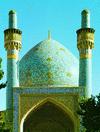- arabesque
-
—arabesquely, adv./ar'euh besk"/, n.1. Fine Arts. a sinuous, spiraling, undulating, or serpentine line or linear motif.2. a pose in ballet in which the dancer stands on one leg with one arm extended in front and the other leg and arm extended behind.3. a short, fanciful musical piece, typically for piano.4. any ornament or ornamental object, as a rug or mosaic, in which flowers, foliage, fruits, vases, animals, and figures are represented in a fancifully combined pattern.adj.5. decorated with or characterized by arabesques: arabesque design.[1605-15; < F < It arabesco ornament in Islamic style, lit., Arabian, equiv. to arab(o) ARAB + -esco -ESQUE]
* * *
Style of decoration characterized by interlacing plant forms and abstract curvilinear motifs.It is typical of Islamic ornamentation from с 1000. The word was first used in the 15th or 16th century when Europeans became interested in the Islamic arts, but the motif itself was derived from Hellenistic craftsmen in Asia Minor. Arabesques were also applied to the decoration of illuminated manuscripts, walls, furniture, metalwork, pottery, stonework, majolica, and tapestry from the Renaissance to the 19th century. Ray ManleyShostal Assoc./EB Inc.
Ray ManleyShostal Assoc./EB Inc.* * *
▪ decorative stylestyle of decoration characterized by intertwining plants and abstract curvilinear motifs. Derived from the work of Hellenistic craftsmen working in Asia Minor, the arabesque originally included birds in a highly naturalistic setting. As adapted by Muslim artisans about AD 1000, it became highly formalized; for religious reasons, no birds, beasts, or human figures were included. The arabesque became an essential part of the decorative tradition of Islāmic cultures.In Europe from the Renaissance until the early 19th century, arabesques were used for the decoration of illuminated manuscripts, walls, furniture, metalwork, and pottery. These designs usually were composed of either twining or sinuous scrolls of branches and leaves or ornate lines abstracted from such natural forms. Human figures often were integral to Western arabesque designs. Though the word had meant simply “Arabian” in 16th-century France, it was defined in a dictionary of 1611 as “rebesque work, a small and curious flourishing.”The earliest Western models inspiring the work of early Renaissance Italian artists were actually ancient Roman stucchi, plaster models found in Roman tombs. Arabesque stonework was designed by the mid-15th century, and painting in the style executed by Giulio Romano and the pupils of Raphael decorated the open galleries, or loggie, of the Vatican in the following century. Delicate silverwork of northern Italy and, later, Spain also used the motifs, and they began to appear in the decoration of majolica at Urbino, armour at Milan, tapestry at Florence, and illuminated manuscripts at Mantua.Renaissance arabesques maintained the classical tradition of median symmetry, freedom in detail, and heterogeneity of ornament. The arabesque of this period also allowed the inclusion of a broad range of elements—human beings, beasts, birds, fishes, flowers—in imaginative or fantasy scenes, usually with copious interlacings of vines, ribbons, or the like.With the coming of the Baroque, the use of arabesque decoration fell into disfavour until the middle of the 18th century, when a new series of Roman arabesques was discovered at Herculaneum. In 1757 the Comte de Caylus published his Recueil de peintures antiques (“Collection of Ancient Paintings”), and by 1770 engraved models for arabesques again were being published in Paris. The late reliefs and paintings are among the most beautiful arabesques ever produced, but the formality of Directoire and Empire design after the Revolution gradually ended the fashion.in literature, a contrived intricate pattern of verbal expression, so called by analogy with a decorative style in which flower, fruit, and sometimes animal outlines appear in elaborate patterns of interlaced lines. That these designs can sometimes suggest fantastic creatures may have given rise to another sense of the term, denoting a tale of wonder or of the supernatural. Nikolay Gogol (Gogol, Nikolay) used this sense of the word in his Arabeski (1835; Arabesques) five years before Edgar Allan Poe (Poe, Edgar Allan) collected some of his tales under the title Tales of the Grotesque and Arabesque. Like those of Poe, Gogol's tales of hallucination, confusing reality and dream, are among his best stories (“Nevsky Prospect” and “Diary of a Madman,” both 1835). The word is French and means “intricate ornament,” which is related to the Italian arabesco, literally, “an ornament in the style of the Arabs.”* * *
Universalium. 2010.
